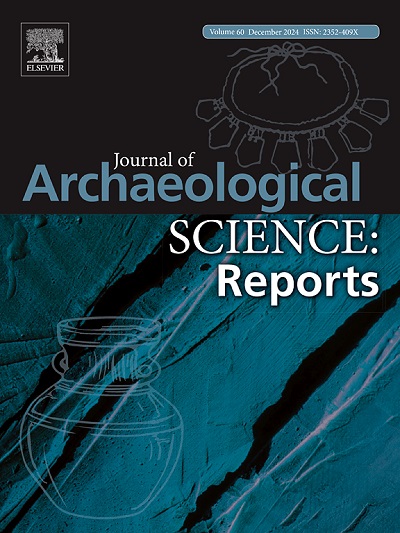北魏蓝——公元4世纪至6世纪中国北方地区钠钙玻璃的本地化生产
IF 1.5
2区 历史学
0 ARCHAEOLOGY
引用次数: 0
摘要
北魏平城时期(公元398-494年),丝绸之路显著复兴,促进了东西方之间的贸易。作为都城,平城(今山西省大同市)在将西方玻璃制品及其制造技术引入东方地区方面发挥了关键作用。虽然《魏书·西域》提供了玻璃制造技术引入的文字证据,但要了解平城时期玻璃器皿的组成和工艺,需要现代仪器分析。本文采用扩展景深的三维数码显微镜和扫描电子显微镜-能谱仪(SEM-EDS)对大同地区北魏时期的三种典型玻璃器皿进行了分析。这种非破坏性的微观分析侧重于玻璃的化学成分和微观形态。对生产技术、原材料及其来源进行了初步调查。与同期邻近地区出土的同类型玻璃器皿和陶器相比较,研究表明,鲜卑族在外来吹制技术和审美的交流融合下,产生了独特的器物风格。结果表明,这些玻璃器皿属于高镁植物灰基na20 - cao - sio2玻璃体系,MgO平均含量为7.2%,高镁钠钙玻璃在世界古代玻璃谱系中较为罕见。玻璃器皿的形状、微观形状和高浓度的镁表明,当地使用当地材料生产,可能受到罗马玻璃吹制技术的影响。本研究为北魏平城时期中外玻璃贸易和技术交流提供了重要的科学信息。本文章由计算机程序翻译,如有差异,请以英文原文为准。
Northern Wei blue — Localized production of sodium calcium glass in Northern China from the 4th to the 6th century AD
The Pingcheng period of the Northern Wei Dynasty (398–494 CE) saw a significant revival of the Silk Road, bolstering trade between the East and West. As the capital, Pingcheng (today’s Datong City, Shanxi Province) played a pivotal role in the introduction of Western glass products and their fabrication techniques to Eastern regions. While the Book of Wei: Western Regions provides textual evidence of the introduction of glassmaking technology, modern instrumental analysis is required to understand the components and craftsmanship of Pingcheng-period glassware. In this study, three typical glassware from the Northern Wei period in Datong area were analyzed using a 3D digital microscope with an extended depth of field and a scanning electron microscope-energy dispersive spectrometer (SEM-EDS). This non-destructive, micro-level analysis focused on the glass’ chemical composition and microscopic morphology. Preliminary investigations were conducted into production techniques, raw materials, and their sources. Compared with the same type of glassware and pottery unearthed in neighboring areas of the same period, the research shows that the foreign blowing technology and aesthetic exchange and fusion of Xianbei nationality produced a unique style of ware. The findings indicate that these glassware belonged to a high Mg, plant ash-based Na2O-CaO-SiO2 glass system, the average content of MgO is 7.2%, and high magnesium sodium calcium glass is relatively rare in the world’s ancient glass lineage. The glassware’ shape, micro shape, and high Mg concentration suggest local production using indigenous materials, likely influenced by Roman glassblowing techniques. This study provides important scientific information regarding the trade and technical exchange of glass between China and foreign countries in Pingcheng period of the Northern Wei Dynasty.
求助全文
通过发布文献求助,成功后即可免费获取论文全文。
去求助
来源期刊

Journal of Archaeological Science-Reports
ARCHAEOLOGY-
CiteScore
3.10
自引率
12.50%
发文量
405
期刊介绍:
Journal of Archaeological Science: Reports is aimed at archaeologists and scientists engaged with the application of scientific techniques and methodologies to all areas of archaeology. The journal focuses on the results of the application of scientific methods to archaeological problems and debates. It will provide a forum for reviews and scientific debate of issues in scientific archaeology and their impact in the wider subject. Journal of Archaeological Science: Reports will publish papers of excellent archaeological science, with regional or wider interest. This will include case studies, reviews and short papers where an established scientific technique sheds light on archaeological questions and debates.
 求助内容:
求助内容: 应助结果提醒方式:
应助结果提醒方式:


